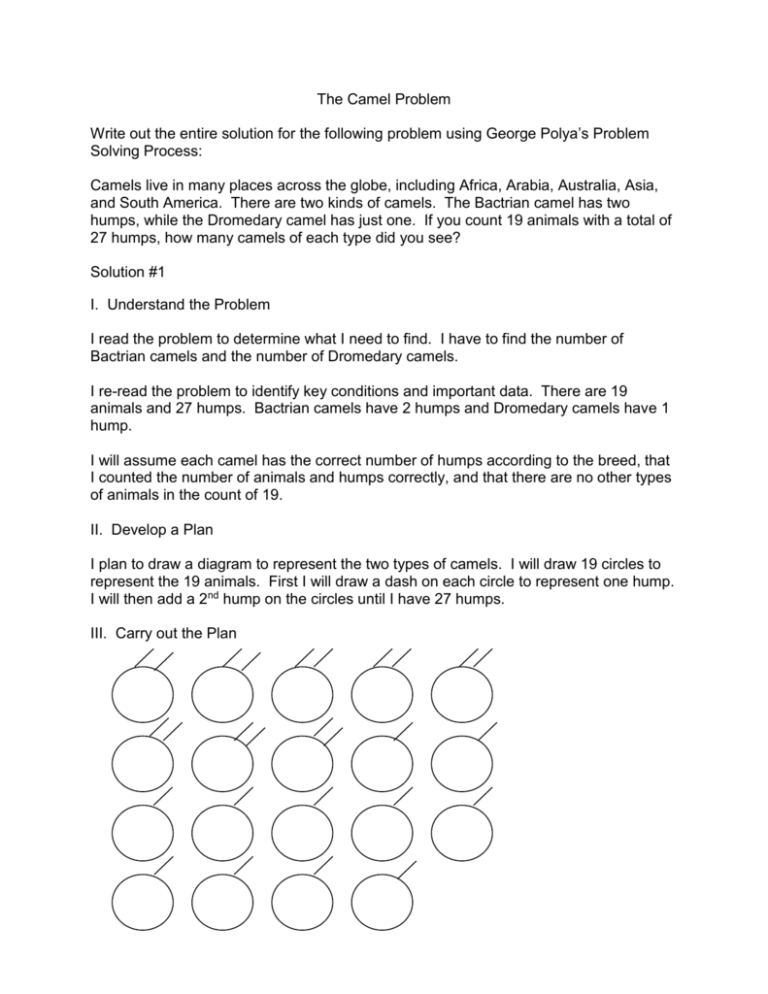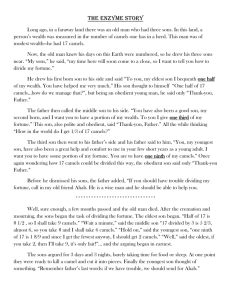Solutions to The Camel Problem
advertisement

The Camel Problem Write out the entire solution for the following problem using George Polya’s Problem Solving Process: Camels live in many places across the globe, including Africa, Arabia, Australia, Asia, and South America. There are two kinds of camels. The Bactrian camel has two humps, while the Dromedary camel has just one. If you count 19 animals with a total of 27 humps, how many camels of each type did you see? Solution #1 I. Understand the Problem I read the problem to determine what I need to find. I have to find the number of Bactrian camels and the number of Dromedary camels. I re-read the problem to identify key conditions and important data. There are 19 animals and 27 humps. Bactrian camels have 2 humps and Dromedary camels have 1 hump. I will assume each camel has the correct number of humps according to the breed, that I counted the number of animals and humps correctly, and that there are no other types of animals in the count of 19. II. Develop a Plan I plan to draw a diagram to represent the two types of camels. I will draw 19 circles to represent the 19 animals. First I will draw a dash on each circle to represent one hump. I will then add a 2nd hump on the circles until I have 27 humps. III. Carry out the Plan answer: There are 8 Bactrian camels and 11 Dromedary camels. IV. Look Back The answer is reasonable and fits the problem interpretation. With 8 Bactrian camels and 11 Dromedary camels there are a total of 19 camels, which is the number of animals. The Bactrian camels account for 16 humps and the Dromedary camels account for 11 humps. That’s a total of 27 humps. This checks for any careless mistakes in the drawing and counting. There is not another answer to the problem, but there are other solutions. It is possible to solve this problem by Guess-Check-Revise. It would be a good idea to use a table or list when doing this. It is also possible to use equations to solve this problem. Any one of these 3 solutions could be used to solve similar problems. Solution #2 I. Understand the Problem I read the problem to determine what I need to find. I have to find the number of Bactrian camels and the number of Dromedary camels. I re-read the problem to identify key conditions and important data. There are 19 animals and 27 humps. Bactrian camels have 2 humps and Dromedary camels have 1 hump. I will assume each camel has the correct number of humps according to the breed, that I counted the number of animals and humps correctly, and that there are no other types of animals in the count of 19. II. Develop a Plan I’m going to use Guess-Check-Revise to solve this problem. I will organize the data in a table. I know the total number of camels is 19, so I’ll select two numbers whose sum is 19. One number will represent the number of Bactrian camels and the other number will represent the number of Dromedary camels. I’ll need to keep track of the number of humps, so I’ll have another column in my table to do this. If my initial guess gives me too many humps, I’ll decrease the number of Bactrian camels. If my initial guess gives me too few humps, I’ll increase the number of Bactrian camels. I’ll continue this until I get 27 humps. III. Carry Out the Plan # of Bactrian Camels 10 9 8 # of Dromedary Camels 9 10 11 # animals 19 19 19 # humps 10(2) + 9(1) = 29 9(2) + 10(1) = 28 8(2) + 11(1) = 27 answer: There are 8 Bactrian camels and 11 Dromedary camels. IV. Look Back The answer is reasonable and fits the problem interpretation. With 8 Bactrian camels and 11 Dromedary camels there are a total of 19 camels, which is the number of animals. The Bactrian camels account for 16 humps and the Dromedary camels account for 11 humps. That’s a total of 27 humps. This checks my calculations. There is not another answer to the problem, but there are other solutions. It is possible to solve this problem by drawing a picture and adjusting the number of humps. It can also be solved by using equations. Any one of these 3 solutions could be used to solve similar problems. Solution #3 I. Understand the Problem I read the problem to determine what I need to find. I have to find the number of Bactrian camels and the number of Dromedary camels. I re-read the problem to identify key conditions and important data. There are 19 animals and 27 humps. Bactrian camels have 2 humps and Dromedary camels have 1 hump. I will assume each camel has the correct number of humps according to the breed, that I counted the number of animals and humps correctly, and that there are no other types of animals in the count of 19. II. Develop a Plan I plan to write 2 equations, each with 2 unknowns. I will let b stand for the number of Bactrian camels and d stand for the number of Dromedary camels. I know that the number of Bactrian camels added with the number of Dromedary camels equals the number of animals. I also know that 2 times the number of Bactrian camels added with 1 times the number of Dromedary camels equals the total number of humps. With 2 equations, I can solve for 2 unknowns. III. Carry out the Plan b + d = 19 2b + 1d = 27 –b – d = -19 2b + d = 27 b =8 b + d = 19 8 + d = 19 d = 11 answer: There are 8 Bactrian camels and 11 Dromedary camels. IV. Look Back The answer is reasonable and fits the problem interpretation. With 8 Bactrian camels and 11 Dromedary camels there is a total of 19 camels, which is the number of animals. The Bactrian camels account for 16 humps and the Dromedary camels account for 11 humps. That’s a total of 27 humps. This checks my calculations. There is not another answer to the problem, but there are other solutions. It is possible to solve this problem by drawing a picture and adjusting the number of humps. It can also be solved by Guess-Check-Revise. It would be a good idea to use a table or list when doing this. Any one of these 3 solutions could be used to solve similar problems.


![KaraCamelprojectpowerpoint[1]](http://s2.studylib.net/store/data/005412772_1-3c0b5a5d2bb8cf50b8ecc63198ba77bd-300x300.png)






